
STS-79 Biographies
| Readdy | Wilcutt | Akers | Walz | Apt | Blaha | Lucid |
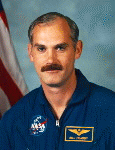 William
F. Readdy, Commander
William
F. Readdy, Commander
NAME: William F. Readdy (Captain, U.S. Naval Reserve) NASA Astronaut
PERSONAL DATA: Born January 24, 1952, in Quonset Point, Rhode Island, but considers McLean, Virginia, to be his hometown. Married to Colleen Nevius. They have two sons and one daughter. He enjoys sailing, racquet sports, flying, reading. His father, Francis Readdy, resides in McLean. Her parents, William and Barbara Nevius, reside in Virginia Beach, Virginia.
EDUCATION: Graduated from McLean High School, McLean, Virginia, in 1970; received a bachelor of science degree in aerospace engineering (with honors) from the U.S. Naval Academy in 1974. Distinguished graduate, U.S. Naval Test Pilot School 1980.
ORGANIZATIONS: Associate Fellow, Society of Experimental Test Pilots; Member, American Astronautical Society, Association of Space Explorers, and Explorers Club.
SPECIAL HONORS: Recipient of the Distinguished Flying Cross, Space Flight Safety Award, NASA Outstanding Leadership Medal, two NASA Exceptional Service Medals, three NASA Space Flight Medals, the Meritorious Service Medal, the Navy Commendation Medal, Navy Achievement Medal, Navy Expeditionary medal, two National Defense Service Medals, Armed Forces Expeditionary Medal, Armed Forces Reserve Medal, and various unit and service awards. U.S. Naval Test Pilot School Instructor of the Year (1984).
EXPERIENCE: Readdy graduated from Annapolis in 1974, and was designated a naval aviator in September 1975 at Beeville, Texas. Following training in the A-6 Intruder at VA-42 Naval Air Station Oceana, Virginia, he joined Attack Squadron 85 aboard the USS Forrestal deployed to the North Atlantic and Mediterranean from 1976 until 1980.
Upon completion of the U.S. Naval Test Pilot School, Patuxent River, Maryland, he served as project pilot on a variety of test programs while assigned to the Strike Aircraft Test Directorate. Following a short tour as an instructor pilot at the U.S. Naval Test Pilot School, he reported in 1984 to the USS Coral Sea, on Caribbean and Mediterranean deployments.
In October 1986 Readdy accepted a Naval Reserve commission and joined NASA as a research pilot. He is affiliated with the U.S. Naval Reserve, and is assigned to the Naval Space Command.
He has logged over 7,000 flying hours in over 60 types of fixed wing and helicopters and over 550 carrier landings.
NASA EXPERIENCE: Readdy joined NASA's Johnson Space Center in October 1986 as an aerospace engineer and instructor pilot at Ellington Field, Houston, Texas, where he served as program manager for the Shuttle Carrier Aircraft. He was selected as an astronaut by NASA in the 1987 Group.
His technical assignments to date include: Orbiter Subsystems, Orbiter Landing and Rollout; Orbiter Project Staff; SAIL; Training Officer; Safety Officer; Operations Development Branch Chief; NASA Director of Operations, Star City, Russia; and the first manager of Space Shuttle Program Development charged with upgrading the Space Shuttle to support human space flight into the next century.
A veteran pilot astronaut with three space flights, STS-42 (January 22-30, 1992), STS-51 (September 12-22, 1993) and STS-79 (September 16-26, 1996), he has logged over 672 hours in space. STS-79 rendezvoused and docked with the Russian Space Station Mir, transferred over 3.5 tons of supplies to and from the Mir and exchanged U.S. astronauts on Mir for the first time - leaving John Blaha and bringing Shannon Lucid home after her record six months stay aboard Mir. Readdy is currently assigned to the Office of Space Flight at NASA Headquarters as Deputy Associate Administrator. He remains on flight status and is eligible for future Space Shuttle mission command.
_______________________________________________________________
| Readdy | Wilcutt | Akers | Walz | Apt | Blaha | Lucid |
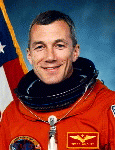 Terrence
W. Wilcutt, Pilot
Terrence
W. Wilcutt, Pilot
NAME: Terrence W. Wilcutt (Colonel, USMC) NASA Astronaut
PERSONAL DATA: Born October 31, 1949, in Russellville, Kentucky. Enjoys flying, running, weight lifting, woodworking.
EDUCATION: Graduated from Southern High School, Louisville, Kentucky in 1967; received a bachelor of arts degree in math from Western Kentucky University in 1974.
ORGANIZATIONS: Member of Society of Experimental Test Pilots (SETP).
SPECIAL HONORS: Distinguished Flying Cross, Defense Superior Service Medal,Defense Meritorious Service Medal, Pritchard Committee for Academic Excellence, NASA Space Flight Medals (4), Navy Commendation Medal, and Sea Service Deployment Ribbon. Distinguished Graduate of the United States Naval Test Pilot School.
EXPERIENCE: After graduation from college in 1974, Wilcutt taught high school math for two years prior to entering the Marine Corps. He was commissioned in 1976 and earned his wings in 1978. Following initial F-4 Phantom training in VMFAT-101, he reported to VMFA-235, Kaneohe, Hawaii. While assigned to VMFA-235, Wilcutt attended the Naval Fighter Weapons School (Topgun) and made two overseas deployments to Japan, Korea, and the Philippines.
In 1983, he was selected for F/A-18 conversion training and served as an F/A-18 Fighter Weapons and Air Combat Maneuvering Instructor in VFA-125, Lemoore, California. In 1986, Wilcutt was selected to attend the United States Naval Test Pilot School (USNTPS),where he earned the title "Distinguished Graduate." Following graduation from USNTPS he was assigned as a test pilot/project officer for Strike Aircraft Test Directorate (SATD) at the Naval Aircraft Test Center, Patuxent River, Maryland. While assigned to SATD, Wilcutt flew the F/A-18 Hornet, the A-7 Corsair II, the F-4 Phantom, and various other aircraft to test a wide variety of projects and classified programs.
He has over 4,400 flight hours in more than 30 different aircraft.
NASA EXPERIENCE: Selected by NASA in January 1990, Wilcutt became an astronaut in July 1991. Technical assignments to date include: work on Space Shuttle Main Engine and External Tank issues; Astronaut Support Personnel team at the Kennedy Space Center, Florida, supporting Space Shuttle launches and landings; technical issues for the Astronaut Office Operations Development Branch; NASA Director of Operations at the Yuri Gagarin Cosmonaut Training Center, Star City, Russia; Chief of the Astronaut Office Shuttle Operations Branch.
He was the pilot on STS-68 in 1994 and STS-79 in 1996, and was the mission commander on STS-89 in 1998 and STS-106 in 2000. A veteran of four space flights, Wilcutt has logged over 1,007 hours in space.
STS-68 Endeavour (September 30 to October 11, 1994) was part of NASAs Mission to Planet Earth. STS-68, Space Radar Lab-2 (SRL-2), was the second flight of three advanced radars called SIR-C/X-SAR (Spaceborne Imaging Radar-C/X-Band Synthetic Aperture Radar), and a carbon-monoxide pollution sensor, MAPS (Measurement of Air Pollution from Satellites). SIR-C/X-SAR and MAPS operated together in Endeavours cargo bay to study Earths surface and atmosphere, creating radar images of Earths surface environment and mapping global production and transport of carbon monoxide pollution. Real-time crew observations of environmental conditions, along with over 14,000 photographs aided the science team in interpreting the SRL data. The SRL-2 mission was a highly successful test of technology intended for long-term environmental and geological monitoring of planet Earth. STS-68 launched from Kennedy Space Center, Florida, and landed at Edwards Air Force Base, California. Mission duration was 11 days, 5 hours, 46 minutes, traveling 4.7 million miles in 183 orbits of the Earth.
STS-79 Atlantis (September 16-26, 1996), the fourth in the joint American-Russian Shuttle-Mir series of missions, launched from and returned to land at Kennedy Space Center, Florida. STS-79 rendezvoused with the Russian MIR space station and ferried supplies, personnel, and scientific equipment to this base 240 miles above the Earth. The crew transferred over 3.5 tons of supplies to and from the Mir and exchanged U.S. astronauts on Mir for the first time - leaving John Blaha and bringing Shannon Lucid home after her record six months stay aboard Mir. Mission duration was 10 days, 3 hours, 18 minutes, traveling 3.9 million miles in 159 orbits of the Earth.
STS-89 (January 22-31, 1998), was the eighth Shuttle-Mir docking mission during which the crew transferred more than 9,000 pounds of scientific equipment, logistical hardware and water from Space Shuttle Endeavour to Mir. In the fifth and last exchange of a U.S. astronaut, STS-89 delivered Andy Thomas to Mir and returned with David Wolf. Mission duration was 8 days, 19 hours and 47 seconds, traveling 3.6 million miles in 138 orbits of the Earth.
_______________________________________________________________
| Readdy | Wilcutt | Akers | Walz | Apt | Blaha | Lucid |
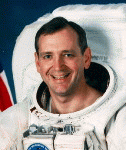 Thomas
D. Akers, Mission Specialist
Thomas
D. Akers, Mission Specialist
NAME: Tom Akers (Colonel, USAF, Ret.) NASA Astronaut (former)
PERSONAL DATA: Born May 20, 1951, in St. Louis, Missouri, but raised and educated in his hometown of Eminence, Missouri. Married to the former Kaye Lynn Parker of Eminence, Missouri. They have two grown children. Tom enjoys hunting, fishing, restoring automobiles, and spending time with his family. His parents, Walter and Arlie Akers, are both deceased.
EDUCATION: Graduated from Eminence High School, Eminence, Missouri, in 1969; received bachelor and master of science degrees in applied mathematics from the University of Missouri-Rolla in 1973 and 1975, respectively.
SPECIAL HONORS: High School Valedictorian. Graduated Summa Cum Laude with a class rank of #1 from University of Missouri-Rolla. Named a Distinguished Graduate of USAF Officer Training School, Squadron Officers School, and Test Pilot School. Recipient of the Department of Defense Superior Service Medal with two oak leaf clusters; Legion of Merit Award; Department of Defense Meritorious Service Medal; USAF Meritorious Service Medal; USAF Commendation Medal; USAF Achievement Medal; NASA Distinguished Service Medal; two NASA Exceptional Service Medals; four NASA Space Flight Medals. Awarded an honorary Doctorate of Engineering from the University of Missouri-Rolla in 1992.
EXPERIENCE: Akers was a National Park Ranger at Alley Springs, Missouri, during the summer seasons from 1972 through 1976. After graduating from the University of Missouri-Rolla in 1975, he spent four years as the high school principal in his hometown of Eminence.
Joining the Air Force in 1979, his first assignment after Officer Training School was to Eglin Air Force Base, Florida, as an air-to-air missile data analyst where he also taught night classes in Math and Physics for Troy State University. In 1982 he was selected to attend the Air Force Test Pilot School at Edwards Air Force Base, California. On completing one year of training as a flight test engineer, in 1983 he was reassigned to Eglin Air Force Base, where he worked on a variety of weapons development programs, flying F-4, F-15, and T-38 aircraft until he was selected for the astronaut program. He has logged over 2,500 hours flying time in 25 different types of aircraft.
NASA EXPERIENCE: Akers was selected for the astronaut program in 1987. Positions held since then include: Astronaut Office focal point for Space Shuttle software development; astronaut representative during Shuttle software testing in the Shuttle Avionics Integration Laboratory (SAIL); supported launch activities at the Kennedy Space Center; astronaut representative for EVA activities (space walks); Deputy Director of Mission Operations; Acting Deputy Director of Flight Crew Operations, and Assistant Director (Technical) of Johnson Space Center.
Akers left the astronaut program and NASA in August of 1997 to return to the USAF as the commander of the USAFROTC Detachment 442 at the University of Missouri-Rolla. Akers retired from the Air Force in October of 1999 and accepted a position as an instructor in the Math Department at the University of Missouri-Rolla.
A veteran of four space flights (STS-41 in 1990, STS-49 in 1992, STS-61 in 1993, STS-79 in 1996), Akers has accumulated over 800 hours of space flight including over 29 hours of space walking experience.
On STS-41, October 6-10, 1990, he was responsible for the missions primary payload, the Ulysses spacecraft. The STS-41 crew successfully deployed the interplanetary probe and started it on its four-year journey via Jupiter to investigate the polar regions of the Sun.
STS-49, May 7-16, 1992, was the maiden flight of the new Space Shuttle Endeavour. The STS-49 crew successfully completed four EVAs (space walks), three rendezvous, and a variety of secondary objectives. Akers was one of a three-member EVA team who successfully captured the stranded INTELSAT (International Telecommunications Satellite). This was the first 3-person EVA and the longest EVA (8.5 hours) in history. Akers also performed a second EVA on this flight to evaluate Space Station Freedom construction techniques.
On STS-61, December 2-13, 1993, Akers again served as an EVA crew member. During the 11-day mission, the crew captured the Hubble Space Telescope and restored it to full capacity through a record five space walks by four astronauts. Akers performed two of these bringing his total EVA time to 29 hours and 40 minutes.
STS-79, September 16-26, 1996, was the fourth Shuttle mission to rendezvous with the Russian Space Station Mir. Akers was the flight engineer and responsible for the transfer of over 3.5 tons of supplies to and from the Mir. This mission also marked the first exchange of U.S. astronauts on Mir - leaving John Blaha and returning Shannon Lucid home after her record six month stay in space.
_______________________________________________________________
| Readdy | Wilcutt | Akers | Walz | Apt | Blaha | Lucid |
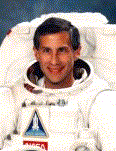 Jay
Apt, Mission Specialist
Jay
Apt, Mission Specialist
NAME: Jay Apt (Ph.D.) NASA Astronaut
PERSONAL DATA: Born April 28, 1949, in Springfield, Massachusetts, but considers Pittsburgh, Pennsylvania, to be his hometown. Married to the former Eleanor B. Emmons. They have two daughters. He enjoys flying, scuba diving, camping, photography, model rocketry, and amateur radio.
EDUCATION: Received a bachelor of arts degree in physics (magna cum laude) from Harvard College in 1971, and a doctorate in physics from the Massachusetts Institute of Technology (MIT) in 1976.
ORGANIZATIONS: Member of the American Astronomical Society (Division of Planetary Science), the American Geophysical Union, the American Physical Society, Sigma Xi, and the American Association for the Advancement of Science.
SPECIAL HONORS: Recipient of NASA Distinguished Service Medal, two NASA Exceptional Service Medals, four NASA Space Flight Medals, the Sergei P. Korolev Diploma of the Federation Aeronautique Internationale, two Komarov Diplomas of the FAI, and three NASA Group Achievement Awards. Winner of First and Second Prizes in the 1996 Aviation Week & Space Technology Magazine Space Photography Contest.
PUBLICATIONS: Dr. Apt shared his images and knowledge in the publication Earth in Orbit: NASA Astronauts Photograph the Earth, written in conjunction with NASA scientists Michael Helfert and Justin Wilkinson and published by the National Geographic Society. Results of Dr. Apt;s research in physics and planetary science have been published in over 20 papers in professional journals.
EXPERIENCE: In 1976, Dr. Apt was a post-doctoral fellow in laser spectroscopy at MIT. From 1976 to 1980 he was a staff member of the Center for Earth & Planetary Physics, Harvard University, supporting NASA's Pioneer Venus Mission by making temperature maps of Venus from Mt. Hopkins Observatory. Dr. Apt served as the Assistant Director of Harvard's Division of Applied Sciences from 1978 to 1980.
NASA EXPERIENCE: In 1980 Dr. Apt joined the Earth and Space Sciences Division of NASA's Jet Propulsion Laboratory (JPL), doing planetary research, studying Venus, Mars, and the outer solar system. In 1981 he became Director of JPL's Table Mountain Observatory. From 1982 through 1985, he was a flight controller responsible for Shuttle payload operations at NASA's Johnson Space Center.
Dr. Apt is an instrument-rated commercial pilot, and has logged over 4,000 hours flying time in approximately 25 different types of airplanes, seaplanes, sailplanes, and human-powered aircraft.
He was selected as an astronaut candidate by NASA in June 1985, and qualified as an astronaut in July 1986. His assignments to date have included Shuttle Orbiter modification support at Kennedy Space Center, developing techniques for servicing the Hubble Space Telescope and the Gamma Ray Observatory, development of EVA (space walk) construction and maintenance techniques for Space Station, as a spacecraft communicator (CAPCOM) for Shuttle flights, the voice link between the flight crew and the Mission Control Center (MCC), and the Astronaut Office EVA point of contact. He has also been the supervisor of Astronaut Training in the Astronaut Office, and has served as Chief of the Astronaut Office Mission Support Branch.
Apt flew as a member of the crew of the Space Shuttle Atlantis on the STS-37 mission, which launched from Kennedy Space Center, Florida, on April 5, 1991. During the mission, the crew deployed the Gamma Ray Observatory to study the universe by observing the most energetic form of radiation. Apt and crew mate Jerry Ross performed an unscheduled space walk during which they manually deployed the observatory's large radio antenna when remotely controlled motors failed to do so. On the next day, they conducted the first scheduled space walk in 5-1/2 years. They tested concepts for getting around on large space structures, and gathered basic engineering data on the forces a crew member can exert on bolts and equipment. The crew alsoconducted research on biologically important molecules, tested concepts for radiating heat from Space Station, operated an amateur radio station, and took over 4000 photographs of the Earth. After completing 93 orbits of the Earth, the crew landed Atlantis at Edwards Air Force Base, California, on April 11, 1991.
Dr. Apt was Endeavour's flight engineer on the crew of STS-47, Spacelab-J. This eight-day cooperative mission between the United States and Japan was launched on September 12, 1992, to perform life science and materials processing experiments in space. Dr. Apt was responsible for operating the Orbiter during one of the two shifts on this dual shift mission. After completing 126 orbits of the Earth, the crew landed Endeavour at Kennedy Space Center, Florida, on September 20, 1992.
He flew again aboard Endeavour on STS-59, the first flight of the Space Radar Laboratory, from April 9-20, 1994. As the blue shift commander, he was responsible for operating Endeavour during one of the two shifts on an 11-day mission to observe the land surface and oceans of Earth with three imaging radar systems, and to map air pollution in the lower atmosphere. The crew flew Endeavour through the largest series of maneuvers in Shuttle history to point the radar precisely at hundreds of ecology, geology, and oceanography sites, providing research scientists the equivalent of 26,000 encyclopedia volumes of data. After completing 183 orbits of the Earth, the crew landed Endeavour at Edwards Air Force Base, California.
Most recently, he served aboard Atlantis during mission STS-79, September 16-26, 1996. The crew docked Atlantis with the Russian Mir Space Station, having ferried supplies, personnel, and scientific equipment to this base 240 miles above the Earth. The crew transferred over 4 tons of scientific experiments and supplies to and from the Mir station and exchanged U.S. astronauts on Mir for the first time - leaving John Blaha and bringing Shannon Lucid home after her record six months stay aboard Mir. This historic mission of international cooperation and scientific research ended at Kennedy Space Center, Florida, after 160 orbits of the Earth.
With the completion of his fourth flight, Dr. Apt has logged over 847 hours (35 days) in space, including 10 hours and 49 minutes on two space walks. He has flown around the Earth 562 times. Dr. Apt left NASA to become Director of the Carnegie Museum of Natural History in Pittsburgh, Pennsylvania.
_______________________________________________________________
| Readdy | Wilcutt | Akers | Walz | Apt | Blaha | Lucid |
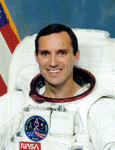 Carl
E. Walz, Mission Specialist
Carl
E. Walz, Mission Specialist
NAME: Carl E. Walz (Colonel, USAF) NASA Astronaut
PERSONAL DATA: Born September 6, 1955, in Cleveland, Ohio. Married to the former Pamela J. Glady of Lyndhurst, Ohio. They have two children. He enjoys piano and vocal music, sports, and is lead singer for MAX-Q, a rock-n-roll band.
EDUCATION: Graduated from Charles F. Brush High School, Lyndhurst, Ohio, in 1973; received a bachelor of science degree in physics from Kent State University, Ohio, in 1977, and a master of science in solid state physics from John Carroll University, Ohio, in 1979.
ORGANIZATIONS: American Legion, KSU Alumni Association.
SPECIAL HONORS: Graduated Summa Cum Laude from Kent State University. Awarded the Defense Superior Service Medal, the USAF Meritorious Service Medal with one Oak Leaf Cluster, the Defense Meritorious Service Medal with one Oak Leaf, the USAF Commendation Medal, and the USAF Achievement Medal with one Oak Leaf Cluster. Distinguished Graduate from the USAF Test Pilot School, Class 83A. Inducted into the Ohio Veterans Hall of Fame. Awarded three NASA Space Flight Medals, NASA Exceptional Service Medal. Distinguished Alumnus Award, Kent State University, 1997.
EXPERIENCE: From 1979 to 1982, Walz was responsible for analysis of radioactive samples from the Atomic Energy Detection System at the 1155th Technical Operations Squadron, McClellan Air Force Base, California. The subsequent year was spent in study as a Flight Test Engineer at the USAF Test Pilot School, Edwards Air Force Base, California. From January 1984 to June 1987, Walz served as a Flight Test Engineer to the F-16 Combined Test Force at Edwards Air Force Base, where he worked on a variety of F-16C airframe avionics and armament development programs. From July 1987 to June 1990, he served as a Flight Test Manager at Detachment 3, Air Force Flight Test Center.
NASA EXPERIENCE: Selected by NASA in January 1990, Walz is a veteran of three space flights, and has logged over 833 hours (34.5 days) in space. He served as a mission specialist on STS-51 in 1993, was the Orbiter flight engineer (MS-2) on STS-65 in 1994, and was a mission specialist on STS-79 in 1996.
Walz is assigned to the fourth crew scheduled to live on the International Space Station (ISS-4). He will launch aboard a Space Shuttle in late 2001 and return aboard a Space Shuttle 4-months later. The crew of three (two American astronauts and one Russian cosmonaut) will perform flight tests of the station hardware, conduct internal and external maintenance tasks, and develop the capability of the station to support the addition of science experiments.
STS-51 Discovery (September 12-22, 1993). During the mission, the five member crew deployed the U.S. Advanced Communications Technology Satellite (ACTS), and the Shuttle Pallet Satellite (SPAS) with NASA and German scientific experiments aboard. Walz also participated in a 7-hour space walk (EVA) to evaluate tools for the Hubble Space Telescope servicing mission. The mission was accomplished in 9 days, 22 hours, and 12 minutes.
STS-65 Columbia (July 8-23, 1994). STS-65 flew the second International Microgravity Laboratory (IML-2) spacelab module, and carried a crew of seven. During the 15-day flight the crew conducted more than 80 experiments focusing on materials and life sciences research in microgravity. The mission completed 236 orbits of the Earth, traveling 6.1 million miles, setting a new flight duration record for the Shuttle program.
STS-79 Atlantis (September 16-26, 1996). On STS-79 the six member crew aboard the Shuttle Atlantis docked with the Russian MIR station, delivered food, water, U.S. scientific experiments and Russian equipment, and exchanged NASA long duration crewmembers. During the mission, the Atlantis/Mir complex set a record for docked mass in space. STS-79 was the first flight of the double Spacehab module, and landed at KSC after 10 days 3 hours and 13 minutes.
_______________________________________________________________
| Readdy | Wilcutt | Akers | Walz | Apt | Blaha | Lucid |
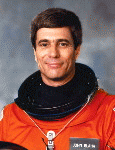 John
E. Blaha, NASA-3 Mir Resident
John
E. Blaha, NASA-3 Mir Resident
NAME: John E. Blaha (Colonel, USAF, Ret.) NASA Astronaut
PERSONAL DATA: Born August 26, 1942, in San Antonio, Texas. Married to the former Brenda I. Walters of St. Louis, Missouri. They have three grown children and two grandchildren.
EDUCATION: Graduated from Granby High School in Norfolk, Virginia, in 1960; received a bachelor of science in engineering science from the United States Air Force Academy in 1965 and a master of science in astronautical engineering from Purdue University in 1966.
ORGANIZATIONS: Association of Space Explorers; Purdue Alumni Association; Society of Experimental Test Pilots; Air Force Academy Association of Graduates; Chairman, Board of Directors Brooks Aerospace Foundation; Member, Committee on Engineering Challenges to the Long Term Operation of the International Space Station, National Research Council Aeronautics and Space Engineering Board.
SPECIAL HONORS: Russian Order of Friendship Medal, 2 NASA Distinguished Service Medals, NASA Outstanding Leadership Medal, NASA Exceptional Service Medal, 5 NASA Space Flight Medals, Countdown Magazine Outstanding Astronaut of 1991, Defense Superior Service Medal, Legion of Merit, 2 Air Force Distinguished Flying Crosses, Defense Meritorious Service Medal, 3 Meritorious Service Medals, 18 Air Medals, Air Force Commendation Medal, the British Royal Air Force Cross, the Vietnam Cross of Gallantry, Purdue Outstanding Aerospace Engineer Award, and the Purdue Engineering Alumnus Award. Outstanding Pilot, F-4 Combat Crew Training. Outstanding Junior Officer of the Year, 3rd Tactical Fighter Wing. Distinguished Graduate Air Force Test Pilot School. Distinguished Graduate Air Command and Staff College. University Roundtable Annual Best and Brightest Award. Grand Marshall Fiesta Flambeau Parade. Grand Marshall Battle of Flowers Parade. Granby High School Hall of Fame.
EXPERIENCE: Blaha received his pilot wings at Williams Air Force Base, Arizona, in 1967. He was subsequently assigned as an operational pilot flying F-4, F-102, F-106, and A-37 aircraft (completing 361 combat missions in Vietnam). He attended the USAF Aerospace Research Pilot School at Edwards Air Force Base, California, in 1971, and piloted the NF-104 research aircraft to 104,400 feet. Following graduation, he served as an F-104 instructor pilot at the test pilot school, teaching low lift-to-drag approach, zoom, performance, stability/control, and spin flight test techniques.
In 1973, he was assigned as a test pilot working with the Royal Air Force at the Aeroplane and Armament Experimental Establishment, Boscombe Down, United Kingdom. During a 3-year tour, he flew stability/control, performance, spin, and weapons delivery flight tests in the Jaguar, Buccaneer, Hawk, and Jet Provost aircraft. In 1976 he attended the USAF Air Command and Staff College. After graduation, he was assigned to work for the Assistant Chief of Staff, Studies and Analyses, at Headquarters USAF in the Pentagon. During this tour, he presented F-15 and F-16 study results to Department of Defense, State Department, and congressional staffs.
NASA EXPERIENCE: Selected as an astronaut in May 1980, Blaha has logged 161 days in space on 5 space missions. He served as pilot on STS-33 and STS 29, was Spacecraft Commander on STS-58 and STS-43, served on Mir-22 as Board Engineer 2, and was a Mission Specialist on STS-79 and STS-81.
In addition to flying 5 space missions, Blaha has served as the Chairman, NASA Space Flight Safety Panel; Weather Manager, Mission Management Team; lead spacecraft communicator; member, NASA Space Shuttle Improvement Panel. Blaha also led the design, development, and integration of the Orbiter Head Up Display system. Additionally, he led the development of contingency abort procedures which significantly improve crew survivability in the event of multiple main engine failures during ascent.
He has logged more than 7,000 hours of flying time in 34 different aircraft, and has written numerous technical articles on spacecraft performance and control.
John Blaha retired from NASA in September 1997 to return to his hometown of San Antonio, Texas, where he joined the Executive Management Group of the United Services Automobile Organization.
STS-29 Discovery launched from Kennedy Space Center, Florida, on March 13, 1989, and landed at Edwards Air Force Base on March 18, 1989. During this very successful mission the five-man crew aboard Shuttle Discovery deployed the East Tracking and Data Relay Satellite, and performed eight scientific/medical experiments.
STS-33 Discovery (November 22-27, 1989). Launched at night, this five-day mission carried Department of Defense payloads and other secondary payloads. After 79 orbits of the Earth, this highly successful mission concluded with a hard surface landing on Runway 4 at Edwards Air Force Base, California.
STS-43 Atlantis (August 2-11, 1991) launched from the Kennedy Space Center carrying a five person crew. During the nine-day mission the crew deployed the West Tracking and Data Relay Satellite, and conducted 32 physical, material, and life science experiments that supported the development of the Extended Duration Orbiter and Space Station. After 142 orbits of the Earth, this very significant mission concluded with a landing on Runway 15 at the Kennedy Space Center, Florida.
STS-58 Columbia (October 18 to November 1, 1993) launched from the Kennedy Space Center carrying a seven-person crew. This record duration fourteen-day life science research mission has been recognized by NASA management as the most successful and efficient Spacelab flight that NASA has flown. The crew performed neurovestibular, cardiovascular, cardiopulmonary, metabolic, and musculoskeletal medical experiments on themselves and 48 rats, expanding our knowledge of human and animal physiology both on Earth and in space flight. In addition, the crew performed 16 engineering tests aboard the Orbiter Columbia and 20 Extended Duration Orbiter Medical Project experiments. Landing was at Edwards Air Force Base on Runway 22.
Blaha began Russian language training in August 1994 at the Defense Language Institute in Monterey, California, and commenced an intensive training program at the Cosmonaut Training Center, Star City, Russia in January 1995. He launched on STS-79 on September 16, 1996. After docking he transferred to the Mir Space Station. Assigned as a Board Engineer 2, he spent the following 4 months with the Mir-22 Cosmonaut crew conducting material science, fluid science, and life science research. Blaha returned to Earth aboard STS-81 on January 22, 1997.
_______________________________________________________________
| Readdy | Wilcutt | Akers | Walz | Apt | Blaha | Lucid |
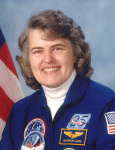 Shannon
W. Lucid, NASA-2 Mir Resident
Shannon
W. Lucid, NASA-2 Mir Resident
NAME: Shannon W. Lucid (Ph.D.) NASA Astronaut
PERSONAL DATA: Born January 14, 1943, in Shanghai, China, but considers Bethany, Oklahoma, to be her hometown. Married to Michael F. Lucid of Indianapolis, Indiana. They have two daughters and one son. She enjoys flying, camping, hiking, and reading. Her parents, Mr. and Mrs. Joseph O. Wells, are deceased.
EDUCATION: Graduated from Bethany High School, Bethany, Oklahoma, in 1960; received a bachelor of science degree in chemistry from the University of Oklahoma in 1963, and master of science and doctor of philosophy degrees in biochemistry from the University of Oklahoma in 1970 and 1973, respectively.
SPECIAL HONORS: The recipient of numerous awards, Dr. Lucid most recently was awarded the Congressional Space Medal of Honor by the President of the United States. She is the first and only woman to have earned this prestigious award. Dr. Lucid was also awarded the Order of Friendship Medal by Russian President Boris Yeltsin. This is one of the highest Russian civilian awards and the highest award that can be presented to a non-citizen.
EXPERIENCE: Dr. Lucids experience includes a variety of academic assignments, such as teaching assistant at the University of Oklahomas Department of Chemistry from 1963 to 1964; senior laboratory technician at the Oklahoma Medical Research Foundation from 1964 to 1966; chemist at Kerr-McGee, Oklahoma City, Oklahoma, 1966 to 1968; graduate assistant at the University of Oklahoma Health Science Centers Department of Biochemistry and Molecular Biology from 1969 to 1973; and research associate with the Oklahoma Medical Research Foundation in Oklahoma City, Oklahoma, from 1974 until her selection to the astronaut candidate training program.
Dr. Lucid is a commercial, instrument, and multi-engine rated pilot.
NASA EXPERIENCE: Selected by NASA in January 1978, Dr. Lucid became an astronaut in August 1979. She is qualified for assignment as a mission specialist on Space Shuttle flight crews. Some of her technical assignments have included: the Shuttle Avionics Integration Laboratory (SAIL); the Flight Software Laboratory, in Downey, California, working with the rendezvous and proximity operations group; Astronaut Office interface at Kennedy Space Center, Florida, participating in payload testing, Shuttle testing, and launch countdowns; spacecraft communicator (CAPCOM) in the JSC Mission Control Center during numerous Space Shuttle missions; Chief of Mission Support; Chief of Astronaut Appearances.
A veteran of five space flights, Dr. Lucid has logged 5,354 hours (223 days) in space. She served as a mission specialist on STS-51G (June 17-24, 1985), STS-34 (October 18-23, 1989), STS-43 (August 2-11, 1991), STS-58 (October 18 to November 1, 1993), and most recently served as a Board Engineer 2 on Russias Space Station Mir (launching March 22, 1996 aboard STS-76 and returning September 26, 1996 aboard STS-79).
Dr. Lucid holds an international record for the most flight hours in orbit by any non-Russian, and holds the record for the most flight hours in orbit by any woman in the world.
STS-51G Discovery (June 17-24, 1985) was a 7-day mission during which crew deployed communications satellites for Mexico (Morelos), the Arab League (Arabsat), and the United States (AT&T Telstar). They used the Remote Manipulator System (RMS) to deploy and later retrieve the SPARTAN satellite which performed 17 hours of x-ray astronomy experiments while separated from the Space Shuttle. In addition, the crew activated the Automated Directional Solidification Furnace (ADSF), six Getaway Specials, and participated in biomedical experiments. The mission was accomplished in 112 orbits of the Earth, traveling 2.5 million miles in 169 hours and 39 minutes. Landing was at Edwards Air Force Base (EAFB), California.
STS-34 Atlantis (October 18-23, 1989) was a 5-day mission during which the deployed the Galileo spacecraft on its journey to explore Jupiter, operated the Shuttle Solar Backscatter Ultraviolet Instrument (SSBUV) to map atmospheric ozone, and performed numerous secondary experiments involving radiation measurements, polymer morphology, lightning research, microgravity effects on plants, and a student experiment on ice crystal growth in space. The mission was accomplished in 79 orbits of the Earth, traveling 1.8 million miles in 119 hours and 41 minutes. Landing was at Edwards Air Force Base, California.
STS-43 Atlantis (August 2-11, 1991) was a nine-day mission during which the crew deployed the fifth Tracking and Data Relay Satellite (TDRS-E). The crew also conducted 32 physical, material, and life science experiments, mostly relating to the Extended Duration Orbiter and Space Station Freedom. The mission was accomplished in 142 orbits of the Earth, traveling 3.7 million miles in 213 hours, 21 minutes, 25 seconds. STS-43 Atlantis was the eighth Space Shuttle to land at KSC).
STS-58 Columbia (October 18 to November 1, 1993). This record duration fourteen-day mission was recognized by NASA management as the most successful and efficient Spacelab flight flown by NASA. The STS-58 crew performed neurovestibular, cardiovascular, cardiopulmonary, metabolic, and musculoskeletal medical experiments on themselves and 48 rats, expanding our knowledge of human and animal physiology both on Earth and in space flight. In addition, they performed 16 engineering tests aboard the Orbiter Columbia and 20 Extended Duration Orbiter Medical Project experiments. The mission was accomplished in 225 orbits of the Earth, traveling 5.8 million miles in 336 hours, 13 minutes, 01 seconds. Landing was at Edwards Air Force Base, California.
In completing this flight Dr. Lucid logged 838 hours, 54 minutes in space making her Americas female space traveler with the most hours in space. Dr. Lucid currently holds the United States single mission space flight endurance record on the Russian Space Station Mir.
Following a year of training in Star City, Russia, her journey started with liftoff at Kennedy Space Center, Florida, on March 22, 1996 aboard STS-76 Atlantis. Following docking, she transferred to the Mir Space Station. Assigned as a Board Engineer 2, she performed numerous life science and physical science experiments during the course of her stay aboard Mir. Her return journey to KSC was made aboard STS-79 Atlantis on September 26, 1996. In completing this mission Dr. Lucid traveled 75.2 million miles in 188 days, 04 hours, 00 minutes, 14 seconds.